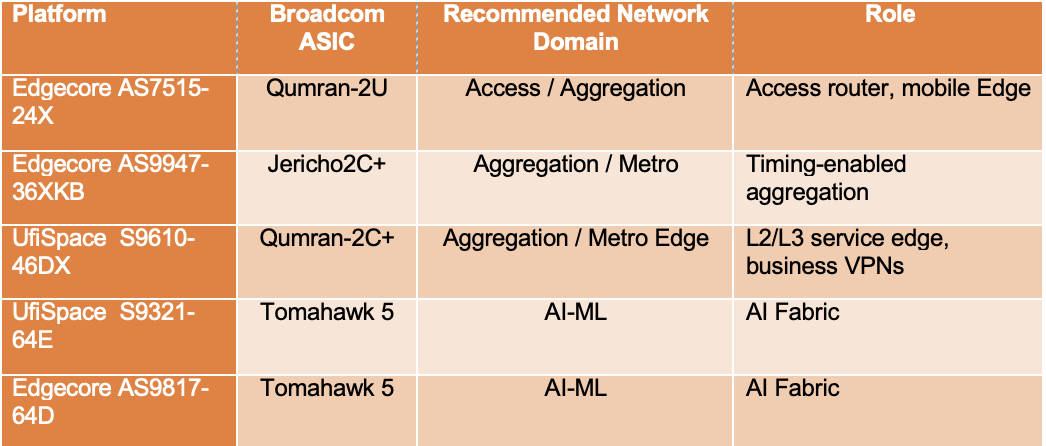New Features for Segment Routing and Ethernet-based AI Fabric
What’s New in Our Upcoming OcNOS Release: Performance, Resilience, and Expanded Feature Support
As part of our commitment to continuous innovation and high-performance networking, we are excited to announce the upcoming release of our next software update OcNOS 6.6.1. This release introduces a robust set of features that enhance Segment Routing, improve the AI/ML workload capabilities, expand protocol support, and improve operational visibility and control across complex service provider and data center networks.
Here’s a look at some of the key capabilities that are coming:
SR-based Micro Loop Avoidance (ISIS as IGP)
We’re introducing micro loop avoidance mechanisms for Segment Routing (SR) with IS-IS as the IGP, improving convergence safety during network reconvergence events. This is especially beneficial in SR networks that demand high reliability with deterministic failover behavior.
ECMP Support for L3VPN
Equal-Cost Multipath (ECMP) is now available for L3VPN, enabling improved load balancing and resiliency across VPN traffic paths — critical for providers managing high-scale MPLS backbones.
BGP Auto-Discovery for LDP VPLS (Including H-VPLS)
We’ve added BGP Auto-Discovery (BGP A-D) support for LDP-based VPLS, including Hierarchical VPLS (H-VPLS). This significantly simplifies provisioning while ensuring flexible and scalable service rollout.
VPLS IRB Support
Integrated Routing and Bridging (IRB) is now available for VPLS, enabling seamless Layer 2 and Layer 3 service integration, especially useful for enterprise VPNs and triple-play environments.
TI-LFA for Flex-Algo
Expanding SR-TI capabilities, we now support Topology-Independent Loop-Free Alternate (TI-LFA) for Flexible Algorithms (Flex-Algo), ensuring fast reroute and high availability across custom topology definitions.
EVPN-VxLAN IRB Support
EVPN-VxLAN IRB (Integrated Routing and Bridging) support on TD4 enables seamless integration of Layer 2 and Layer 3 networks. This feature allows for:
- Scalable and flexible network design: EVPN-VxLAN IRB support enables the creation of large-scale, virtualized networks with ease.
- Simplified network management: With EVPN-VxLAN IRB, network administrators can manage both Layer 2 and Layer 3 networks from a single platform.
Dynamic Load Balancing
The Dynamic Load Balancing feature ensures that network traffic is distributed efficiently across multiple paths, providing:
- Improved network utilization: Optimizes network resource usage, reducing congestion and packet loss.
- Enhanced network reliability: By dynamically adjusting traffic distribution, OcNOS minimizes the impact of network failures and outages
Explicit Congestion Notification (ECN)
ECN enables early detection and notification of network congestion, allowing for:
- Proactive congestion management: ECN helps network administrators identify and address congestion issues before they impact network performance.
- Improved network efficiency: By avoiding congestion, ECN helps reduce packet loss, latency, and jitter.
Priority-based Flow Control (PFC) over L3 Interfaces
PFC enables precise control over network traffic, ensuring:
- Predictable network performance: PFC over L3 ensures that critical traffic is prioritized and delivered with low latency and jitter.
- Enhanced network security: By controlling traffic flow, PFC over L3 helps prevent network congestion
Enhanced Transmission Selection (ETS)
ETS provides a robust framework for managing network traffic, enabling:
- Flexible traffic management: ETS allows network administrators to define and manage traffic policies based on application requirements.
- Improved network efficiency: By optimizing traffic transmission, ETS helps reduce network congestion and packet loss.
New Hardware Platform Support
In response to evolving capacity and deployment needs, this release also expands hardware compatibility, introducing support for a range of next-generation, high-performance platforms. These platforms offer increased throughput, port density, and silicon diversity for optimized use in access, aggregation, and DCI applications.

These platforms, now supported with OcNOS, offer the right combination of silicon acceleration, port flexibility, and carrier-grade features to meet the evolving demands of modern IP/MPLS transport networks.
Why It Matters
This release reflects our continued focus on service assurance, protocol scalability, and flexibility in network design. Whether you’re building advanced MPLS services, segment routing architectures, or delivering high-performance access networks — this update is packed with capabilities that keep your infrastructure future-ready.
Availability
The release is scheduled for 30th June 2025. Documentation and upgrade instructions will be available on the IP Infusion website as well as on the support portal.
Get Ready
Reach out to your IP Infusion Sales representative to learn more about migration options and how these features can enhance your deployments.

Rishi Narain is the Director of Product Management for IP Infusion.

